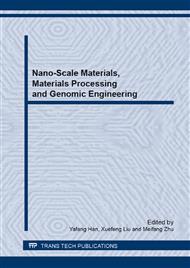[1]
V. Vega,U. Nguyen Huynh,J. Holmes,J. DeChellis, P. Stoyanov, D. Piatknowski, E.W. Lee, J. Ogren, N. Drusina, O.S. Es-Said, Analysis of heat effects on marine corps AM2 mat mechanical properties, J. Mater. Eng. Perform. 20(2011)257-264.
DOI: 10.1007/s11665-010-9669-2
Google Scholar
[2]
Y.Q. Ding, Y. Zhang, D.O. Northwood, A.T. Alpas, PVD NiAl intermetallic coatings: microstructure and mechanical properties, Surf. Coat. Technol. 94-95 (1997)483–489.
DOI: 10.1016/s0257-8972(97)00344-7
Google Scholar
[3]
S.Sampath, B. Katz, H. Herman, Vacuum plasma sprayed hard coatings, Mém. Etudes Sci. Rev.Métall., 88(1991)289.
Google Scholar
[4]
S.Sampath,R.Tiwari, B.Gudmundsson, H.Herman, Microstructure and properties of plasma-spray consolidated two-phase nickel aluminides, Scripta Metall. Mater. 25(1991)1425-1430.
DOI: 10.1016/0956-716x(91)90427-3
Google Scholar
[5]
S.Sampath, X.Y. Jiang, J. Matejicek, L. Prchlik, A. Kulkarni, A. Vaidya, Role of thermal spray processing method on the microstructure, residual stress and properties of coatings: an integrated study for Ni-5wt.%Al bond coats, Mater. Sci. Eng. A. 364 (2004) 216–231.
DOI: 10.1016/j.msea.2003.08.023
Google Scholar
[6]
S.Deshpande, S. Sampath, H. Zhang, Mechanisms of oxidation and its role in microstructural evolution of metallic thermal spray coatings—case study for Ni–Al, Surf. Coat. Technol. 200(2006)5395–5406.
DOI: 10.1016/j.surfcoat.2005.07.072
Google Scholar
[7]
L. Prchlik, S. Sampath, Effect of the microstructure of thermally sprayed coatings on friction and wear response under lubricated and dry sliding conditions, Wear, 262(2007)11-23.
DOI: 10.1016/j.wear.2006.03.042
Google Scholar
[8]
S. Sampath, G.A. Bancke, H. Herman, S. Rangaswamy, Plasma sprayed Ni-Al coatings, Surf. Eng. 5 (1989)293–298.
DOI: 10.1179/sur.1989.5.4.293
Google Scholar
[9]
G.A. López,S.Sommadossi,P.Zieba,W gust,E.J Mittemeijer, Kinetic behavior of diffusion-soldered Ni/Al/Ni interconnections, Chem. Phys. 78(2002)459-463.
DOI: 10.1016/s0254-0584(02)00232-8
Google Scholar
[10]
F. Kozo, H. Zenji, Measurement of intrinsic diffusion coefficients of Al and Ni in Ni3Al using Ni/NiAl diffusion couples, Acta Mater. 50(2002)1571-1579.
DOI: 10.1016/s1359-6454(02)00018-6
Google Scholar
[11]
D.F Susan, A.R Marder, Ni–Al composite coatings: diffusion analysis and coating lifetime estimation, Acta Mater. 49(2001)1153-1163.
DOI: 10.1016/s1359-6454(01)00022-2
Google Scholar
[12]
M. Lieblich,J. L. Gonzalez-Carrasco, F. Garcia-Cano, Asymmetrical phase growth in a PM Al/Ni3Al composite, J. Mater. Sci. Lett. 18(1999)905-908.
DOI: 10.1023/a:1006668815274
Google Scholar
[13]
H.A. Pour, M. Lieblich, S.G. Shabestari, M.T. Salehi, Influence of pre-oxidation of NiAl intermetallic particles on thermal stability of Al/NiAlp composites at 500℃, Scripta Mater. 53(2005) 977-982.
DOI: 10.1016/j.scriptamat.2005.06.023
Google Scholar


